IDEAVENTIONS ACADEMY
 Today’s topic is about teaching Engineering as a core curriculum class. We’re walking backwards in S-T-E-M. We started with M - Math and today we’ll focus on the E - Engineering. Anyone who has an engineering degree may say, “Engineering as a class is too broad!” Biomedical Engineering is very different from Computer Engineering and those two fields are very different from Civil Engineering. And, I agree. To set some context, when I talk about the Engineering Design process or cycle, in its simplest form, it is:
The primary goal of our engineering program is to teach kids how to think like engineers so that it becomes second nature to them. In other words, we want kids to learn how to think like the problem solvers of the world. A secondary goal of our engineering program is to teach kids the skills that they need to implement, or create, the solutions that their minds come up with. Finally, we want to expose kids to the variety of engineering disciplines. How will they know if they like it if they don’t know it exists? When I think back to my education at TJ and at MIT, what comes to mind is that I learned how to think and how to solve problems. I can’t remember the specific facts of what I learned in biotech lab or specific dates I learned in humanities. What I do remember was the constant problem solving and learning how to take an ambiguous problem or challenge, structure a solution and execute on it. That skillset (and hard work), the engineering skillset, is what has carried me through in my career and in life in general. With the Next Generation Science Standards, we found that many science curricula now integrate engineering activities. We think that this is great! You may ask, “Do you still need a separate engineering class?” Yes! We think that kids still need a focused engineering class for two reasons:
Science and Engineering (and Math and Computer Science) are very related and are synergistic, but there are different skills and thought process that occur with each (more to come on this philosophy in a separate post). The goal for this class is learning how to come up with solutions and to think like an engineer. In our science classes, the goal for kids will be to learn to question and seek answers like a scientist. We want students that when given a problem, have the confidence, strategies and skills to come up with a solution and not look to someone else to give them the answer or tell them how to do it - which is too often what happens with many children. We selected the two curricula for the initial year because they provide a great introduction to engineering with real-world problems. They also give us challenges that span various engineering disciplines. We will use the Engineering is Elementary (combination of EiE, Engineering Everywhere andEngineering Adventures) for 4th and 5th grade students and It’s About Time's Engineering the Future for 6th and 7th grade students. We can expand or modify them by using different materials to solve the challenges. If cardboard is not sturdy enough, let’s use wood. What is more frustrating than having an idea and not being able to make it real? By teaching kids how to safely use woodworking tools, sewing machines, and 3D printers, among other tools, they will now have the skills with which to implement their solutions. Finally, we round out our engineering curriculum by giving kids the opportunity to solve problems that we need for their local environment. Do we need a sign directing people on where to go? Or to build a wireless weather station to know the temperature outside? That’s a problem to be solved by the kids. Do we need an exhibit for next year’s Nova Maker Faire or US Science and Engineering Festival? Those are challenges to be solved by the kids. As needs arise within our own school community, the lab is a great place to engineer those solutions. Have a great week!
0 Comments
 Music is feeling, music is expression and music can be magic. We knew from the beginning that music would be part of our core curriculum at Ideaventions Academy. As I told my own kids, music is good for the soul. Why? In researching the benefits of music, I came across a number of studies that have shown the positive effects of the active engagement in music on concentration, community bonding, among others. Frank Fitzpatrick explains it best in his blog Music and the Brain: Rhythm and Playing. What? What immediately came to mind when I thought of a music program was Stomp (introduced to me by an Ideaventions family). Our goal is to give children a program that teaches them how to experience music anywhere, with anything, while having fun! And, while I used to “trek” up to Harvard to listen to the St. Paul’s Boys Choir on Sundays, I knew that for Ideaventions Academy, our music program needed to have movement. I have seen the negative effects of repeated, stressful rehearsals with an expectation of perfection on young children. Instead of loving and appreciating music, the kids got turned away from music or developed anxiety. This reinforced our core philosophy of fun music anywhere. From a practical standpoint, we had to account for children’s varied experience with different instruments, their temperament, natural abilities and the goals of music education in a micro school setting. When I think back to basics of my music education and years of playing clarinet, three core concepts that come to mind are keeping the beat (think tapping the foot), being able to hear pitch and feeling the rhythm (and in the case of the clarinet, also knowing how to breathe was key). That’s what a music program based on drumming provides. It teaches kids how to 1) keep a steady beat, 2) internalize the rhythm in music and 3) learn over time how to hear differences in pitch. Kids can then take these three core skills to any other musical instrument that they want to learn to play or are already playing outside of school. How? I was very fortunate to be introduced to Kofi Dennis by my children’s music teacher. In working with him, the idea for the music program took shape - hand drums, specifically, the djembe. If you have not had the opportunity to see African drums and how much fun it can be, check out this video. Kofi has developed our music program, Drumming for Concepts, whose primary goals are for children to: a) Work to enhance their music capabilities and independence, and b) Nurture the music within oneself, one's community and world To read more about music and music education, check out Frank Patrick’s blog on Huffington Post.  Happy St. Patrick's Day! I have green on my mind, so today's Teaching Tuesday topic is about our Morning Nature Walk. I first learned about this through my children's elementary school, Sunset Hills Montessori. This is a practice that one of their former teachers began and it's one of the reasons why we chose the school. Therefore, when we began to think about Ideaventions Academy and what our students' days would be like, this daily practice was at the top of my list. To me, it's a way to start the day off right. There are so many dimensions on why I believe that starting the school day with a morning nature walk is highly beneficial to kids. Nature Appreciation I was lucky enough to be able to join my kids' classes on their morning walks last year. Being able to observe what kids do in a loosely-structured, natural learning environment has been one of my favorite experiences in education. From the squeals of joy when the flower we’d been looking at every day finally bloomed, to the dead snake that we found and photographed on our path, to the turtle we observed standing on a log by the lake, to the various leaves and seeds that we didn't recognize, to even getting soaked one day when a rain storm caught us by surprise, I learned so much from the kids on these walks. Since the first day, I realized that the learning opportunities are endless and child driven. Reset After the Morning Rush When I think of our weekday mornings, it’s a picture of the mad dash to get in the car by 8 am. Even when everything is pre-packed, the clothes laid out and the backpacks in the car from the night before, we're always still rushed to get to school on time. And, sometimes, one of us wakes up on the wrong side of the bed. Whenever I’m stressed or upset, walking outside clears my head. Think about the last time you had a bad day and you went out for a walk or went to the gym and worked out. Didn't you feel better afterwards? Physical Exercise Every time I take my kids to see their pediatrician, one thing that we talk about consistently is that all kids should be getting one hour of physical exercise every day. One goal of our morning routine is to provide some of that physical time for kids at their natural pace. We envision having groups of kids that will move at different speeds. We imagine having 1) The runners - the group of kids to whom being outdoors means freedom and take off on a run, 2) The walkers - the group of kids who like to walk and/or talk and 3) The observers, these are the kids, who stop and discover every new ant hill or who stop to collect the leaves that have fallen. Depending on each child's energy level, having this energy release to start his or her day, whether it's a run, a walk or a slow stroll, may make the difference on how hard they need to work in order to learn. Improved Memory and Concentration I had the opportunity to attend a talk by Dr. John Gabrieli in December and part of the discussion centered around memory as we age. It was a fascinating talk overall, but one part of his talk really resonated with me. It was that the one thing that has been scientifically proven to improve memory in seniors is aerobic exercise multiple times per week. The effect on kids still needs more research, but there have been various studies on the positive effect of exercise on memory and cognition of adolescents. We want to provide kids the opportunity learn more easily, and also to introduce them to a habit that will benefit them for the rest of their lives. Social and Emotional Well-Being The time spent in an outdoor setting also gives children an opportunity for social time, both with their friends and with their teachers. We view school a place for academics, as well as a place to develop their social and emotional well-being. I remember learning so much about what really interested the on our walks last year. There were two boys who loved science and would spend half of the walk talking about various science experiments with me, or the boy who saw the mist over the lake and started making up stories about pirates. I was also able to learn kids' natural dispositions so that if a child was particularly quiet that day or out of sorts, there was a low-key chance to ask if there was anything he or she wanted to talk about. I am so excited to be able to take this great start to the day to more children. Lastly, if you want more ideas for how to spend time with nature, check out Todd Christopher's, The Green Hour, I highly recommend it.  Welcome to our new blog for Ideaventions Academy. On Tuesdays, we will be talking about our educational philosophy. We’ll be discussing topics such as homework, recess, or diving into why we have selected a particular curriculum. On Fridays, we will give you an update on our progress towards opening our doors in September. Whether it’s a construction update, the announcement of a new teacher or the selection of a curriculum, you’ll have an opportunity to join us on this amazing experience! The topic of our first Teaching Tuesday blog is Math for the gifted. Math for gifted students is especially challenging because:
Although Ideaventions Academy is a school for gifted children with a passion for the STEM fields, we envisioned similar challenges that would be encountered in a regular education classroom. Even though our class size is about eight students (much smaller than the typical public school, or even private school class), those eight students can be working at five different grade levels in math at the beginning of the year. Additionally, we expect that for some of our incoming students, their true math potential has not yet been tapped. We also recognized that each person has strengths and weaknesses within math. Think about your own math experience. Did you like geometry? How about algebra? What about probability? Even if you loved math, some math concepts came more easily to you than other math concepts. This holds true for our kids. Additionally, we have some students, who are very gifted in math, but may have learning differences and we want to develop their math talent while supporting their specific need. After much thought, we developed our requirements set for a math program:
We concluded that our math program would be a blended learning environment. Students would work on math using the online program to progress through their mathematical concepts at their own pace. In the small class environment, if a student has a question or needs a concept clarified, our teacher is there to provide the immediate support. For introverted or shy students, our teacher reviews the students’ progress daily and pulls those students that need the additional help in the next class session. The goal is that students receive immediate intervention in areas where they need help, while being able to work quickly through concepts that they easily master. Group work and real-life problems using math (to answer the question kids always ask, “When am I ever going to use this when I grow up?”) is taught through hands-on engineering and math projects. To start our search, we used the summary of online math programs in the marketplace from The Davidson Institute for Talent Development. We evaluated the different math programs and determined that Stanford University’s EPGY (Education Program for Gifted Youth), now GiftedandTalented.com, fit our needs the best. We especially liked that the program was developed specifically for academically gifted students, providing the depth and breadth that we were looking for. We are very excited to have kids working at their own pace. We want them to be challenged, but not stressed. We want them to have a good foundation in math, but learn it in such a way where they see the beauty in numbers and in problem solving. Being someone to whom numbers tell a story, I want kids to be able to discover this. We are enthusiastic about our math program! To read more:
We'll catch up again this Friday, with our Friday Update. Have a great rest of the week! |
AuthorJuliana Heitz is co-founder of Ideaventions Academy and is very excited to share the thinking behind the Academy. Archives
October 2023
Categories |
Copyright © 2010-2024| 12340 Pinecrest Road, Reston, Virginia 20191 | 703-860-0211 | [email protected] | Tax ID 27-2420631 | CEEB Code 470033
 RSS Feed
RSS Feed




